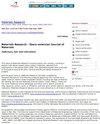Influence of Flexographic Photopolymer-Plate Residue Incorporation on the Mechanical Properties of Glass-Fiber-Reinforced Polyester Composites
IF 1.3
4区 材料科学
Q4 MATERIALS SCIENCE, MULTIDISCIPLINARY
Materials Research-ibero-american Journal of Materials
Pub Date : 2023-08-25
DOI:10.1590/1980-5373-mr-2023-0239
引用次数: 0
Abstract
In this study, the effects of incorporating recycled photopolymer-plate residues from a packaging flexography process into polyester-glass fiber composites were examined. Ternary composites with an unsaturated polyester matrix with elastomer particles from recycled photopolymer-plate residues were evaluated using two types of glass fibers: in the forms of a fabric with bidirectional fibers and a blanket with multidirectional fibers. The composites were prepared by hand lay-up lamination using different rubber contents (0, 2.5, 5, and 10 wt% based on the polyester resin mass fraction), and were characterized for their void content, flexural and impact strengths, and dynamic mechanical properties. Primary results indicated that the incorporation of the rubber particles increased the difficulty of lamination, while promoting greater void formation with higher filler content. The rubber particles decreased the impact resistance properties but did not reduce the flexural strength or storage modulus, indicating that despite the elastomeric composition, this residue from the photopolymer plates showed a reinforcing rather than toughening character.柔性版光敏聚合物-板渣掺入对玻璃纤维增强聚酯复合材料力学性能的影响
本文章由计算机程序翻译,如有差异,请以英文原文为准。
求助全文
约1分钟内获得全文
求助全文
来源期刊

Materials Research-ibero-american Journal of Materials
MATERIALS SCIENCE, MULTIDISCIPLINARY-
CiteScore
2.40
自引率
11.80%
发文量
161
审稿时长
3 months
期刊介绍:
Information not localized
 求助内容:
求助内容: 应助结果提醒方式:
应助结果提醒方式:


